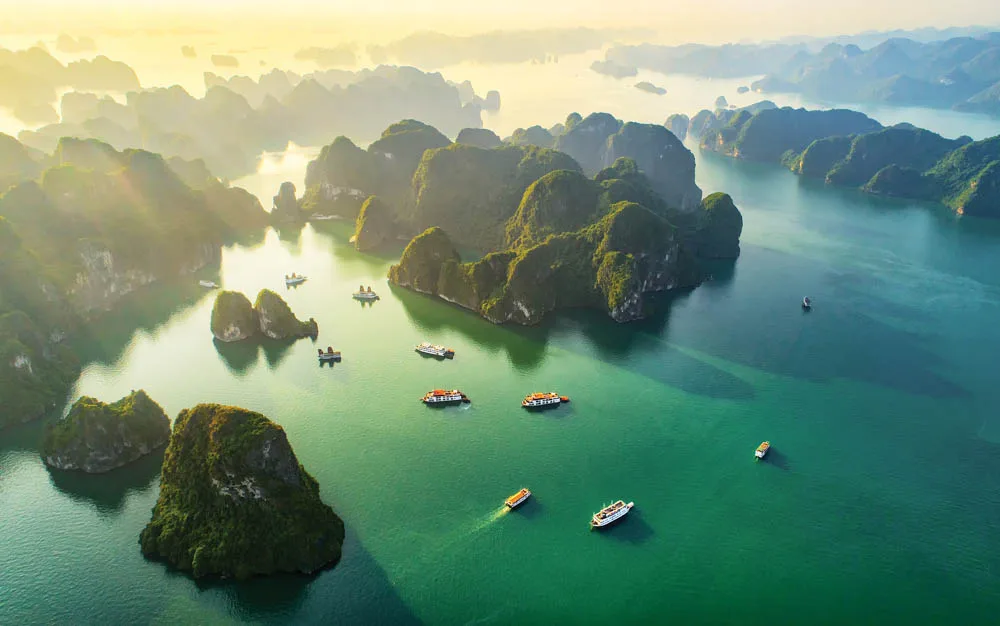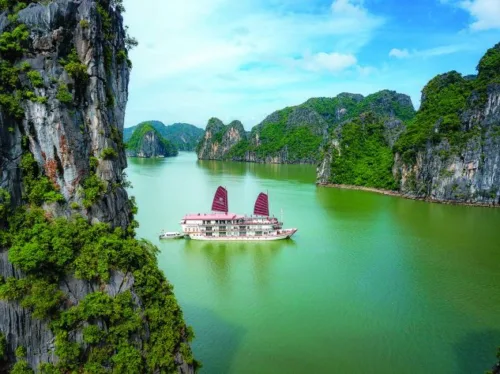Some of the most spectacular scenery in Vietnam is in the Tonkin region stretching from the Hoang Lien Son Mountains (Tonkinese Alps) eastward across the Red River Delta to the islands of Halong Bay. This area is home to many hilltribes, some of which have not been influenced by Vietnamese or Western life.
A favourite vacation spot for Hanoi locals is Sam Son beach, 16 kilometres south-east of Thanh Hoa. The Tam Dao Hill Station, founded by the French in 1907, consists of weathered grand colonial villas. Here there is superb scenery, refreshing weather and good hiking trails.
Hoa Lu was the capital of Vietnam under the Dinh Dynasty (968-980) and Pre-Le (980-1009). The ancient citadel covers an area of three square kilometres and the outer ramparts enclose temples, shrines and the place where the king conducted his court.
Two sanctuaries worth visiting are the temples of King Dinh Tien Hoang and King Le Dai Hanh. A short boat trip away is Bich Dong Grotto in the village of Van Lam, and the Tam Coc Caves and the Xuyen Thuy Grotto.
Close to the town city of Ninh Binh is the Cuc Phuong National Park, great for nature lovers. The Perfume Pagoda is one of several pagodas and Buddhist shrines built into limestone cliffs in the Huong Tich Mountain. A few hours drive from Hanoi is Halong Bay. With its 1969 islands rising from the waters of the Gulf of Tonkin, it is an awe-inspiring sight and an absolute must on any itinerary. Day or overnight boat trips are easily arranged and are the ideal way to take in the spectacular islands.
Hanoi
Hanoi is Vietnam’s capital as well as the political, economic and cultural centre of the country. This beautiful, charming city was chosen as the capital by King Ly Thai To in 1010 and was renamed Thang Long (the Soaring Dragon) and Hanoi has been the capital ever since. Rich in ancient history, Hanoi preserves almost 600 pagodas, temples and many streets with centuries-old architecture busy with trade activities. The city also preserves its poetic features with rows of trees lining both sides of the streets, parks covering dozens of hectares and natural lakes.
Tourists can visit President Ho Chi Minh’s Mausoleum, Co Loa Citadel, the One Pillar Pagoda, the Temple of Literature (Van Mieu Quoc Tu Giam, the oldest university in Vietnam), Quan Su Pagoda – the official centre of Vietnamese Buddhism, Chua Thay, the Master’s Pagoda, Tay Phuong Pagoda, Lenin Thong Nhat and Thu Le Parks, the Hoan Kiem Lake and the West Lake.
Other attractions include Vietnam National Museum of History, the Vietnam Military History Museum, the Museum of Fine Arts and a suburban village, where visitors can acquaint themselves with the life of Vietnamese peasants. The Old Quarter of 36 ancient trading streets is a fascinating area to explore, with its bustling trade and tunnel houses. In some of the quiet streets off beautiful Hoan Kiem Lake are an increasing number of boutiques and gift/ souvenir shops that combine local and modern styles, with delightful restaurants and cafés in historic shophouses.


